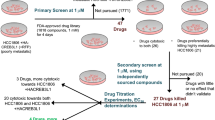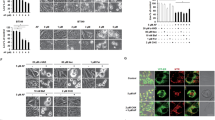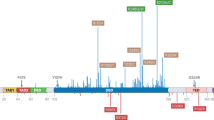Abstract
Aminoflavone (AF, NSC 686288) is beginning clinical trials. It induces replication-mediated histone H2AX phosphorylation, DNA–protein crosslinks and activates p53. Here, we studied p21CIP1/WAF1 and Mdm2 responses to AF. Although p53 stabilization and phosphorylation at serine 15 increased with dose and time of exposure, Mdm2 and p21CIP1/WAF1 protein levels displayed a biphasic response, as they accumulated at submicromolar doses and then decreased with increasing AF. As both Mdm2 and p21CIP1/WAF1 mRNA levels increased with AF concentration without reduction at higher concentrations, we measured the half-lives of Mdm2 and p21CIP1/WAF1 proteins. Mdm2 and p21CIP1/WAF1 half-lives were shortened with increasing AF concentrations. Proteasomal degradation appears responsible for the decrease of both Mdm2 and p21CIP1/WAF1, as MG-132 prevented their degradation and revealed AF-induced Mdm2 polyubiquitylation. AF also induced protein kinase B (Akt) activation, which was reduced with increasing AF concentrations. Suppression of Akt by small interfering RNA was associated with downregulation of Mdm2 and p21CIP1/WAF1 and with enhanced apoptosis. These results suggest that the cellular responses to AF are determined at least in part by Mdm2 and p21CIP1/WAF1 protein levels, as well as by Akt activity, leading either to cell cycle arrest when Mdm2 and p21CIP1/WAF1 are elevated, or to apoptosis when Mdm2 and p21CIP1/WAF1 are degraded by the proteasome and Akt insufficiently activated to protect against apoptosis.
This is a preview of subscription content, access via your institution
Access options
Subscribe to this journal
Receive 50 print issues and online access
$259.00 per year
only $5.18 per issue
Buy this article
- Purchase on Springer Link
- Instant access to full article PDF
Prices may be subject to local taxes which are calculated during checkout






Similar content being viewed by others
Abbreviations
- AF:
-
aminoflavone
- CHX:
-
cycloheximide
- siRNA:
-
small interfering RNA
References
Brooks CL, Gu W . (2003). Ubiquitination, phosphorylation and acetylation: the molecular basis for p53 regulation. Curr Opin Cell Biol 15: 164–171.
Canman CE, Lim DS, Cimprich KA, Taya Y, Tamai K, Sakaguchi K et al. (1998). Activation of the ATM kinase by ionizing radiation and phosphorylation of p53. Science 281: 1677–1679.
Chen C, Meng LH, Ma X, Krausz KW, Pommier Y, Idle JR et al. (2006). Urinary metabolite profiling reveals CYP1A2-mediated metabolism of aminoflavone (NSC 686288). J Pharmacol Exp Ther.
Dotto GP . (2000). p21(WAF1/Cip1): more than a break to the cell cycle? Biochim Biophys Acta 1471: M43–M56.
Fang L, Li G, Liu G, Lee SW, Aaronson SA . (2001). p53 induction of heparin-binding EGF-like growth factor counteracts p53 growth suppression through activation of MAPK and PI3K/Akt signaling cascades. EMBO J 20: 1931–1939.
Feng J, Tamaskovic R, Yang Z, Brazil DP, Merlo A, Hess D et al. (2004). Stabilization of Mdm2 via decreased ubiquitination is mediated by protein kinase B/Akt-dependent phosphorylation. J Biol Chem 279: 35510–35517.
Fujiwara Y, Kawada K, Takano D, Tanimura S, Ozaki K, Kohno M . (2006). Inhibition of the PI3 kinase/Akt pathway enhances doxorubicin-induced apoptotic cell death in tumor cells in a p53-dependent manner. Biochem Biophys Res Commun 340: 560–566.
Furuta T, Hayward RL, Meng LH, Takemura H, Aune GJ, Bonner WM et al. (2006). p21(CDKN1A) allows the repair of replication-mediated DNA double-strand breaks induced by topoisomerase I and is inactivated by the checkpoint kinase inhibitor 7-hydroxystaurosporine. Oncogene 25: 2839–2849.
Hayward RL, Macpherson JS, Cummings J, Monia BP, Smyth JF, Jodrell DI . (2003). Antisense Bcl-xl down-regulation switches the response to topoisomerase I inhibition from senescence to apoptosis in colorectal cancer cells, enhancing global cytotoxicity. Clin Cancer Res 9: 2856–2865.
Jin Y, Lee H, Zeng SX, Dai MS, Lu H . (2003). MDM2 promotes p21waf1/cip1 proteasomal turnover independently of ubiquitylation. EMBO J 22: 6365–6377.
Khosravi R, Maya R, Gottlieb T, Oren M, Shiloh Y, Shkedy D . (1999). Rapid ATM-dependent phosphorylation of MDM2 precedes p53 accumulation in response to DNA damage. Proc Natl Acad Sci USA 96: 14973–14977.
Kim GY, Mercer SE, Ewton DZ, Yan Z, Jin K, Friedman E . (2002). The stress-activated protein kinases p38 alpha and JNK1 stabilize p21(Cip1) by phosphorylation. J Biol Chem 277: 29792–29802.
Knuefermann C, Lu Y, Liu B, Jin W, Liang K, Wu L et al. (2003). HER2/PI-3K/Akt activation leads to a multidrug resistance in human breast adenocarcinoma cells. Oncogene 22: 3205–3212.
Kohn KW . (1999). Molecular interaction map of the mammalian cell cycle control and DNA repair systems. Mol Biol Cell 10: 2703–2734.
Kohn KW, Pommier Y . (2005). Molecular interaction map of the p53 and Mdm2 logic elements, which control the Off–On switch of p53 in response to DNA damage. Biochem Biophys Res Commun 331: 816–827.
Kulikov R, Boehme KA, Blattner C . (2005). Glycogen synthase kinase 3-dependent phosphorylation of Mdm2 regulates p53 abundance. Mol Cell Biol 25: 7170–7180.
Li Y, Dowbenko D, Lasky LA . (2002). AKT/PKB phosphorylation of p21Cip/WAF1 enhances protein stability of p21Cip/WAF1 and promotes cell survival. J Biol Chem 277: 11352–11361.
Maya R, Balass M, Kim ST, Shkedy D, Leal JF, Shifman O et al. (2001). ATM-dependent phosphorylation of Mdm2 on serine 395: role in p53 activation by DNA damage. Genes Dev 15: 1067–1077.
Meek DW . (2004). The p53 response to DNA damage. DNA Repair (Amsterdam) 3: 1049–1056.
Meng L, Shankavaram U, Chen C, Agama K, Fu H, Gonzalez F et al. (2006). Activation of aminoflavone (NSC 686288) by a sulfotransferase is required for the drug's antiproliferative effect and for induction of histone γ-H2AX. Cancer Res 66: 9656–9664.
Meng LH, Kohlhagen G, Liao ZY, Antony S, Sausville E, Pommier Y . (2005). DNA-protein cross-links and replication-dependent histone H2AX phosphorylation induced by aminoflavone (NSC 686288), a novel anticancer agent active against human breast cancer cells. Cancer Res 65: 5337–5343.
Meng LH, Zhang H, Hayward L, Takemura H, Shao RG, Pommier Y . (2004). Tetrandrine induces early G1 arrest in human colon carcinoma cells by down-regulating the activity and inducing the degradation of G1-S-specific cyclin-dependent kinases and by inducing p53 and p21Cip1. Cancer Res 64: 9086–9092.
Michael D, Oren M . (2003). The p53-Mdm2 module and the ubiquitin system. Semin Cancer Biol 13: 49–58.
Milne D, Kampanis P, Nicol S, Dias S, Campbell DG, Fuller-Pace F et al. (2004). A novel site of AKT-mediated phosphorylation in the human MDM2 onco-protein. FEBS Lett 577: 270–276.
Monks A, Scudiero DA, Johnson GS, Paull KD, Sausville EA . (1997). The NCI anti-cancer drug screen: a smart screen to identify effectors of novel targets. Anticancer Drug Des 12: 533–541.
Paull KD, Shoemaker RH, Hodes L, Monks A, Scudiero DA, Rubinstein L et al. (1989). Display and analysis of patterns of differential activity of drugs against human tumor cell lines: development of mean graph and COMPARE algorithm. J Natl Cancer Inst 81: 1088–1092.
Pommier Y, Sordet O, Rao VA, Zhang H, Kohn KW . (2005). Targeting chk2 kinase: molecular interaction maps and therapeutic rationale. Curr Pharm Des 11: 2855–2872.
Rossig L, Badorff C, Holzmann Y, Zeiher AM, Dimmeler S . (2002). Glycogen synthase kinase-3 couples AKT-dependent signaling to the regulation of p21Cip1 degradation. J Biol Chem 277: 9684–9689.
Sarbassov DD, Guertin DA, Ali SM, Sabatini DM . (2005). Phosphorylation and regulation of Akt/PKB by the rictor-mTOR complex. Science 307: 1098–1101.
Shieh SY, Ahn J, Tamai K, Taya Y, Prives C . (2000). The human homologs of checkpoint kinases Chk1 and Cds1 (Chk2) phosphorylate p53 at multiple DNA damage-inducible sites. Genes Dev 14: 289–300.
Sordet O, Khan QA, Kohn KW, Pommier Y . (2003). Apoptosis induced by topoisomerase inhibitors. Curr Med Chem Anticancer Agents 3: 271–290.
Stommel JM, Wahl GM . (2004). Accelerated MDM2 auto-degradation induced by DNA-damage kinases is required for p53 activation. EMBO J 23: 1547–1556.
Takimoto R, El-Deiry WS . (2001). DNA replication blockade impairs p53-transactivation. Proc Natl Acad Sci USA 98: 781–783.
Touitou R, Richardson J, Bose S, Nakanishi M, Rivett J, Allday MJ . (2001). A degradation signal located in the C-terminus of p21WAF1/CIP1 is a binding site for the C8 alpha-subunit of the 20S proteasome. EMBO J 20: 2367–2375.
Viniegra JG, Martinez N, Modirassari P, Losa JH, Parada Cobo C, Lobo VJ et al. (2005). Full activation of PKB/Akt in response to insulin or ionizing radiation is mediated through ATM. J Biol Chem 280: 4029–4036.
Wu X, Bayle JH, Olson D, Levine AJ . (1993). The p53-mdm-2 autoregulatory feedback loop. Genes Dev 7: 1126–1132.
Yoeli-Lerner M, Toker A . (2006). Akt/PKB signaling in cancer: a function in cell motility and invasion. Cell Cycle 5: 603–605.
Yu J, Zhang L . (2005). The transcriptional targets of p53 in apoptosis control. Biochem Biophys Res Commun 331: 851–858.
Zhang Z, Wang H, Li M, Agrawal S, Chen X, Zhang R . (2004). MDM2 is a negative regulator of p21WAF1/CIP1, independent of p53. J Biol Chem 279: 16000–16006.
Zhao Y, You H, Yang Y, Wei L, Zhang X, Yao L et al. (2004). Distinctive regulation and function of PI 3K/Akt and MAPKs in doxorubicin-induced apoptosis of human lung adenocarcinoma cells. J Cell Biochem 91: 621–632.
Acknowledgements
This research was supported by the Intramural Research Program of the NIH, National Cancer Institute, Center for Cancer Research. We thank Dr Natasha Caplen for providing Akt siRNA and Dr Yong Wan for providing HA-ubiquitin plasmid.
Author information
Authors and Affiliations
Corresponding author
Rights and permissions
About this article
Cite this article
Meng, Lh., Kohn, K. & Pommier, Y. Dose–response transition from cell cycle arrest to apoptosis with selective degradation of Mdm2 and p21WAF1/CIP1 in response to the novel anticancer agent, aminoflavone (NSC 686288). Oncogene 26, 4806–4816 (2007). https://doi.org/10.1038/sj.onc.1210283
Received:
Revised:
Accepted:
Published:
Issue Date:
DOI: https://doi.org/10.1038/sj.onc.1210283



